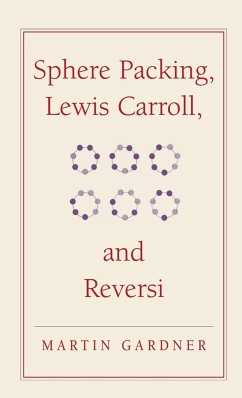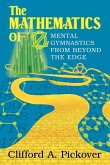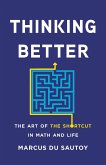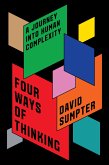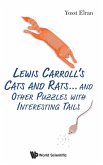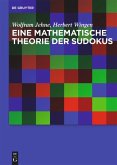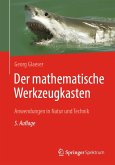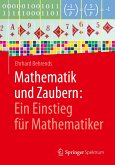Martin Gardner
Sphere Packing, Lewis Carroll, and Reversi
Martin Gardner's New Mathematical Diversions
Martin Gardner
Sphere Packing, Lewis Carroll, and Reversi
Martin Gardner's New Mathematical Diversions
- Gebundenes Buch
- Merkliste
- Auf die Merkliste
- Bewerten Bewerten
- Teilen
- Produkt teilen
- Produkterinnerung
- Produkterinnerung
The latest on packing spheres, Reversi, braids, polyominoes, board games, digits of pi, and the puzzles of Lewis Carroll.
Andere Kunden interessierten sich auch für
![The Mathematics of Oz The Mathematics of Oz]() Clifford A. PickoverThe Mathematics of Oz19,99 €
Clifford A. PickoverThe Mathematics of Oz19,99 €![Thinking Better Thinking Better]() Marcus Du SautoyThinking Better25,99 €
Marcus Du SautoyThinking Better25,99 €![Four Ways of Thinking Four Ways of Thinking]() David SumpterFour Ways of Thinking24,99 €
David SumpterFour Ways of Thinking24,99 €![LEWIS CARROLL'S CATS AND RATS LEWIS CARROLL'S CATS AND RATS]() Yossi ElranLEWIS CARROLL'S CATS AND RATS38,99 €
Yossi ElranLEWIS CARROLL'S CATS AND RATS38,99 €![Eine mathematische Theorie der Sudokus Eine mathematische Theorie der Sudokus]() Wolfram JehneEine mathematische Theorie der Sudokus104,95 €
Wolfram JehneEine mathematische Theorie der Sudokus104,95 €![Der mathematische Werkzeugkasten Der mathematische Werkzeugkasten]() Georg GlaeserDer mathematische Werkzeugkasten37,99 €
Georg GlaeserDer mathematische Werkzeugkasten37,99 €![Mathematik und Zaubern: Ein Einstieg für Mathematiker Mathematik und Zaubern: Ein Einstieg für Mathematiker]() Ehrhard BehrendsMathematik und Zaubern: Ein Einstieg für Mathematiker44,99 €
Ehrhard BehrendsMathematik und Zaubern: Ein Einstieg für Mathematiker44,99 €-
-
-
The latest on packing spheres, Reversi, braids, polyominoes, board games, digits of pi, and the puzzles of Lewis Carroll.
Hinweis: Dieser Artikel kann nur an eine deutsche Lieferadresse ausgeliefert werden.
Hinweis: Dieser Artikel kann nur an eine deutsche Lieferadresse ausgeliefert werden.
Produktdetails
- Produktdetails
- Verlag: Cambridge University Press
- Seitenzahl: 298
- Erscheinungstermin: 30. April 2013
- Englisch
- Abmessung: 222mm x 145mm x 20mm
- Gewicht: 509g
- ISBN-13: 9780521756075
- ISBN-10: 0521756073
- Artikelnr.: 25611767
- Herstellerkennzeichnung
- Libri GmbH
- Europaallee 1
- 36244 Bad Hersfeld
- gpsr@libri.de
- Verlag: Cambridge University Press
- Seitenzahl: 298
- Erscheinungstermin: 30. April 2013
- Englisch
- Abmessung: 222mm x 145mm x 20mm
- Gewicht: 509g
- ISBN-13: 9780521756075
- ISBN-10: 0521756073
- Artikelnr.: 25611767
- Herstellerkennzeichnung
- Libri GmbH
- Europaallee 1
- 36244 Bad Hersfeld
- gpsr@libri.de
For 25 of his 90 years, Martin Gardner wrote 'Mathematical Games and Recreations,' a monthly column for Scientific American magazine. These columns have inspired hundreds of thousands of readers to delve more deeply into the large world of mathematics. He has also made significant contributions to magic, philosophy, debunking pseudoscience, and children's literature. He has produced more than 60 books, including many best sellers, most of which are still in print. His Annotated Alice has sold more than a million copies. He continues to write a regular column for the Skeptical Inquirer magazine.
1. The binary system
2. Group theory and braids
3. Eight problems
4. The games and puzzles of Lewis Carroll
5. Paper cutting
6. Board games
7. Sphere packing
8. The transcendental number Pi
9. Victor Eigen, mathemagician
10. The four-color map theorem
11. Mr. Apollinax visits New York
12. Nine problems
13. Polyominoes and fault-free rectangles
14. Euler's spoilers: the discovery of an Order-10 Graeco-Latin square
15. The ellipse
16. The 24 color squares and the 30 color cubes
17. H. S. M. Coxeter
18. Bridg-it and other games
19. Nine more problems
20. The calculus of finite differences.
2. Group theory and braids
3. Eight problems
4. The games and puzzles of Lewis Carroll
5. Paper cutting
6. Board games
7. Sphere packing
8. The transcendental number Pi
9. Victor Eigen, mathemagician
10. The four-color map theorem
11. Mr. Apollinax visits New York
12. Nine problems
13. Polyominoes and fault-free rectangles
14. Euler's spoilers: the discovery of an Order-10 Graeco-Latin square
15. The ellipse
16. The 24 color squares and the 30 color cubes
17. H. S. M. Coxeter
18. Bridg-it and other games
19. Nine more problems
20. The calculus of finite differences.
1. The binary system; 2. Group theory and braids; 3. Eight problems; 4. The games and puzzles of Lewis Carroll; 5. Paper cutting; 6. Board games; 7. Sphere packing; 8. The transcendental number Pi; 9. Victor Eigen, mathemagician; 10. The four-color map theorem; 11. Mr. Apollinax visits New York; 12. Nine problems; 13. Polyominoes and fault-free rectangles; 14. Euler's spoilers: the discovery of an Order-10 Graeco-Latin square; 15. The ellipse; 16. The 24 color squares and the 30 color cubes; 17. H. S. M. Coxeter; 18. Bridg-it and other games; 19. Nine more problems; 20. The calculus of finite differences.
1. The binary system
2. Group theory and braids
3. Eight problems
4. The games and puzzles of Lewis Carroll
5. Paper cutting
6. Board games
7. Sphere packing
8. The transcendental number Pi
9. Victor Eigen, mathemagician
10. The four-color map theorem
11. Mr. Apollinax visits New York
12. Nine problems
13. Polyominoes and fault-free rectangles
14. Euler's spoilers: the discovery of an Order-10 Graeco-Latin square
15. The ellipse
16. The 24 color squares and the 30 color cubes
17. H. S. M. Coxeter
18. Bridg-it and other games
19. Nine more problems
20. The calculus of finite differences.
2. Group theory and braids
3. Eight problems
4. The games and puzzles of Lewis Carroll
5. Paper cutting
6. Board games
7. Sphere packing
8. The transcendental number Pi
9. Victor Eigen, mathemagician
10. The four-color map theorem
11. Mr. Apollinax visits New York
12. Nine problems
13. Polyominoes and fault-free rectangles
14. Euler's spoilers: the discovery of an Order-10 Graeco-Latin square
15. The ellipse
16. The 24 color squares and the 30 color cubes
17. H. S. M. Coxeter
18. Bridg-it and other games
19. Nine more problems
20. The calculus of finite differences.
1. The binary system; 2. Group theory and braids; 3. Eight problems; 4. The games and puzzles of Lewis Carroll; 5. Paper cutting; 6. Board games; 7. Sphere packing; 8. The transcendental number Pi; 9. Victor Eigen, mathemagician; 10. The four-color map theorem; 11. Mr. Apollinax visits New York; 12. Nine problems; 13. Polyominoes and fault-free rectangles; 14. Euler's spoilers: the discovery of an Order-10 Graeco-Latin square; 15. The ellipse; 16. The 24 color squares and the 30 color cubes; 17. H. S. M. Coxeter; 18. Bridg-it and other games; 19. Nine more problems; 20. The calculus of finite differences.

